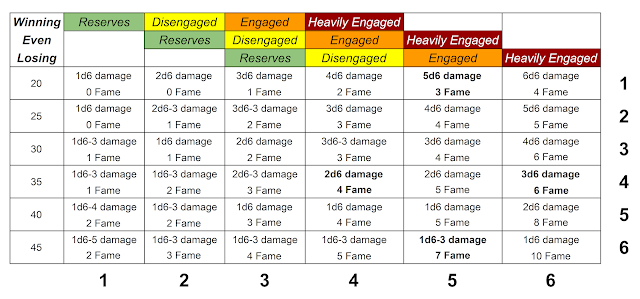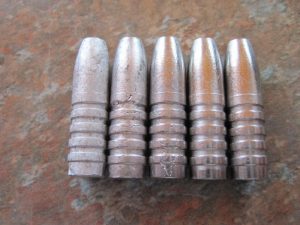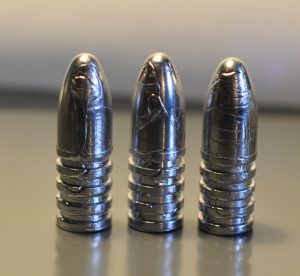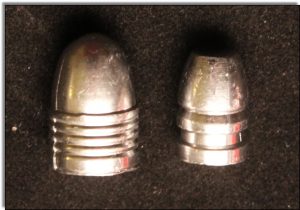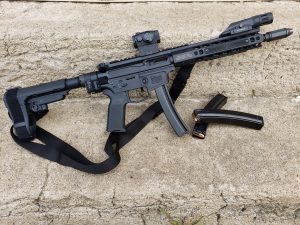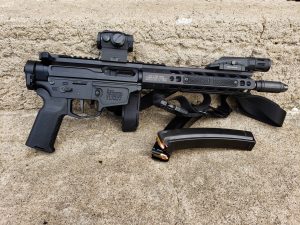There are many rules in Pathfinder for adjudicating battles against armies; I highly recommend
Mass Combat Rules for Pathfinder by Saraiso, aka Sarah Wilson, which takes the rules from Paizo's
Ultimate Campaign and melds them with cherries picked from Legendary Games'
Ultimate Battle and her own ideas.
The problem with these rules is that, although they are very good, they fail to address a critical question:
How do you account for player characters in mass battle? Skirmishes, which are most fights in Pathfinder, can take several hours to play out; playing through a pitched battle on such a scale would take forever. Clearly, some manner of abstraction is needed, preferably one where the players themselves can participate in the fight and whose decisions can help shift the tide of battle.
I eventually settled upon adapting the mass combat rules from the excellent
Legend of the 5 Rings RPG, where the players could choose the level of their characters' engagement (in the Reserves, Disengaged, Engaged, or Heavily Engaged) and then by consulting a matrix of engagement level and whether their army was winning, losing, or holding steady I could determine how badly their characters were hurt, if they contributed to the success of the battle, and how glorious their deeds were.
I playtested these rules last weekend. My PCs were engaged in a "Magnificent Seven" style battle last weekend, except on a much larger scale as they defended a community of deep gnomes against an invading drow army. For a playtest they worked well enough, although there is clearly room for improvement. It is my hope that enough experienced players and GMs will help me polish out the imperfections and deliver a more streamlined system.
 |
| Morning of the Battle of Agincourt, 25 October 1415, by Sir John Gilbert |
Flow of Battle
- Consult the Battle Matrix (see below). Roll 1d6 to determine how many Heroic Opportunities there will be in a battle, then determine their placement using a d6 for X and Y coordinates.
- Run the battle using Saraiso's rules. After running the Melee phase but before the Rout phase, consult these rules for the Hero phase (Phase 3.5).
- Determine if the PC's army is currently winning the battle, losing the battle, or evenly matched. Generally the army which has inflicted the most damage upon the other in the Ranged and Melee phases is winning; in cases where the damage is minimal or a tie, whoever won the Tactical Initiative is winning the battle. If it's still not clear, assume the battle is Even.
- Have the players place their characters in one of four categories: Reserves, Disengaged, Engaged, Heavily Engaged.
- Reserves are the furthest from the fighting you can be and still be considered in the battle. This is where many spellcasters choose to stand, either to heal the wounded or to cast battle-affecting spells. Siege engines and their operators are in this band as well.
- Feats required: Far Shot to hit the enemy with non-siege ranged weapons. (Spells are not weapons.)
- Disengaged is where most ranged attackers are, such as archers, crossbowyers, gunslingers, javelineers, etc. as well as spellcasters who are casting combat spells.
- Precise Shot to hit the enemy with ranged weapons.
- Engaged is where the action is. Some ranged attacks are possible, but this is mainly the province of melee fighters.
- Feats required: Shot on the Run to hit the enemy with ranged weapons.
- Spellcasters must Cast Defensively or suffer +1d6 damage from Attacks of Opportunity.
- Heavily Engaged is the tip of the spear where the fighting is at its most brutal. Only the most skilled fighters and the heavily armored can hope to last long here.
- Feats required: Snap Shot hit the enemy with ranged weapons.
- Spellcasters must Cast Defensively or suffer +1d6 damage from Attacks of Opportunity.
- TIP: it is recommended that you group the PCs by engagement level, starting with those Heavily Engaged and working your way to Reserves.
- Each PC rolls 1d20 + AC + their best to-hit bonus. This is called the Battle Roll, and represents how well they do in combat both offensively and defensively. Compare it to the leftmost column to determine which row they are in.
- Based on their level of engagement and the success of their army, find their position on the chart. Roll for damage and assign Fame.
- If there is a Heroic Opportunity on that chart position, ask the player if they wish to make use of it. If so, see Heroic Opportunities, below. If not, move to the next player.
- When all PCs have taken damage and earned Fame, resume the mass battle at Phase 4 - Rout.
- When the battle is concluded, tally up the total Fame for each PC. See Fame, below, for more information.
Battle Matrix
Locations of Heroic Opportunities are in bold.
Actions in Combat
Player characters do more than trade blows and take damage in skirmishes, and so it is in mass battle as well. Once per turn, a PC may take ONE action:
- Move up or down one level of engagement
- Drink a potion
- Use a scroll
- Cast a spell upon himself or another PC (both must be at the same level of engagement)
- Channel energy
- Expend rage
- Use Bardic or Raging song
Using scrolls or casting spells at any level above Disengaged requires
Casting Defensively.
Heroic Opportunities
Because the player characters are heroes, their presence can shift the tides of battle if they are in the right place at the right time. This occurs when their Battle Rolls place them in a spot on the Matrix where a Heroic Opportunity is indicated.
Heroic Opportunities should be individualized for the character based on his abilities and position within battle. For example, a bard might notice a unit about to rout and rouse them to victory with a use of Inspire Courage, whereas a cleric might channel energy at the right time to heal the wounded or a wizard might engage in a long-range duel with another spellcaster. The actual details are unimportant so long as they suit the PC and thrill the player.
The mechanics of Heroic Opportunities are as follows:
- The player is notified of the Heroic Opportunity for his character. If he accepts, that is his Action in Combat (see above) for the round. If he declines, he can take another action but the Opportunity is lost.
- Based on the situation the GM describes, have the PC roll something suitable such as Profession: Soldier, a Saving Throw, a To Hit roll, a Caster Level Check, etc. The DC should be high but not impossible; something in the range of character level + 15 or 20 should do.
- If the PC succeeds, he earns double the Fame for this round and the GM applies a modifier to one of the armies this round. This is typically a +1 to OM, DV, Morale or Tactical Initiative to his army, or a -1 to OM, DV, Morale or Tactical Initiative to an opposing army.
- If the PC fails, he wounds he suffered this turn are doubled.
Fame
Fame is used to reward player characters for their valiant deeds in battle in lieu of experience points. This way, no one is penalized for for having fewer hit points or a lower armor class than others and all PCs continue to progress along the same XP track.
After a battle, tally up the Fame totals for each character, then consult this table from Pathfinder Society. This represents found magical items scavenged from dead enemies, treasure looted from bodies, noblemen taken ransom, and so forth. This gold piece value can be used to upgrade existing equipment or purchase new magical items with GM permission.
Unused Fame
If a character has more fame than can be used (for example, she has 29 Fame, and uses 27 of it to acquire 11,750 gp of magical upgrades) then she must choose one or more of the following:
- Bank it for the next Mass Combat;
- Convert it into skill levels of Profession: Soldier (depending on circumstance, Profession: Sailor or Profession: Siege Engineer might also be appropriate);
- Keep it to use as a Morale bonus for all Charisma-related skills (each point of Fame so used gives a +1 to the skill check up to character level; such points are deducted from the Fame total);
- With GM permission, given to another character so they may reach a higher Fame tier.
Known Problems & Desired Fixes
As mentioned, this is a playtest and not everything has been worked out or sufficiently balanced. It is entirely possible that some of my numbers are too high or too low and need to be adjusted. I welcome feedback on this issue.
Here are the problems I have:
- I do not know if the Battle Roll is properly balanced. My 5th level PCs scored consistently high, but that might be because of my failure with #2 below. It has been suggested that I halve the total of the Battle Roll, and possibly add 1/2 the PC's level to it as well. Math isn't my strong suit so I don't know if this would be a good fix or not.
- Battle turns are measured in hours, which means that most buffing spells and class abilities will not last for the entirety of the battle. My mistake was that I thought they were measured in minutes and so allowed the buffs to carry throughout the battle. This might account for my players' remarkable success; it might have also kept them alive when in fact my numbers were too lethal. I need more playtesting on this to be sure.
- My players and I both agree that 1 battle turn = 1 hour is too damn long. The battle I GM'd ran for 4 turns, which seemed like a good length of time for a battle as it took most of the evening and left the PCs feeling satisfied.
- Following the Mass Battle rules as written, that means the battle I ran would have lasted for FOUR HOURS. This is too long for anyone to fight without experiencing severe fatigue and/or retiring to the reserves to rest.
- Since fatigue in battle is not a feature of Saraiso's rules, I feel it reasonable to house-rule the duration of each battle round to 10 or 15 minutes (I'm still undecided on which it should be).
- This makes is somewhat easier to adjudicate buffs, although I confess I still don't know what to do with buffs which last less than half a battle turn.
- I am aware that some medieval battles lasted for hours; Agincourt took 3 and Hasting was 8+. I don't know how to handle this because I don't know how to model exhaustion of forces in the field and how they cna be replaced by reserves. This is a problem with the Mass Battle rules, and while somewhat of a cop-out I feel the most honest answer is "This article isn't trying to fix those rules, just find a way to incorporate PCs into them."
- That said, if people want to take a hand at fixing those problem I'd love to hear their solutions.
- As PCs increase in level, they will quickly top out the matrix. I would like for the DC to vary according to their level to that the matrix can be used for all parties regardless of their level. The rows probably ought to be measured as DC [level] + [base number] but I'm not sure what each [base number] ought to be.
- Is Fame too high? I don't know. I don't think it is, but as stated my players all have 5th level characters. Perhaps it's too high for lower level characters; perhaps it's insultingly low for higher level characters.
- I don't know if random assignment of Heroic Opportunities is the right way to go. I do know that I want them weighted towards the harder end of the spectrum, but I also know that I want them to be available to all characters instead of just the front-line combatants. More risk ought to equal more reward, and I don't wish to hand out HO's like participation trophies, yet I also want to give wizards a chance to shine as well. This, like the Battle Roll, is probably a job for a mathematician or a statistician and not a grammar nerd like me.
I welcome any and all feedback on these rules. I hope you find them interesting and useful, and that they find a place within your game.




